Prevalence of potential mediators of artemisinin resistance in African isolates of Plasmodium falciparum
- PMID: 34856982
- PMCID: PMC8638531
- DOI: 10.1186/s12936-021-03987-6
Prevalence of potential mediators of artemisinin resistance in African isolates of Plasmodium falciparum
Abstract
Background: The devastating public health impact of malaria has prompted the need for effective interventions. Malaria control gained traction after the introduction of artemisinin-based combination therapy (ACT). However, the emergence of artemisinin (ART) partial resistance in Southeast Asia and emerging reports of delayed parasite sensitivity to ACT in African parasites signal a gradual trend towards treatment failure. Monitoring the prevalence of mutations associated with artemisinin resistance in African populations is necessary to stop resistance in its tracks. Mutations in Plasmodium falciparum genes pfk13, pfcoronin and pfatpase6 have been linked with ART partial resistance.
Methods: Findings from published research articles on the prevalence of pfk13, pfcoronin and pfatpase6 polymorphisms in Africa were collated. PubMed, Embase and Google Scholar were searched for relevant articles reporting polymorphisms in these genes across Africa from 2014 to August 2021, for pfk13 and pfcoronin. For pfatpase6, relevant articles between 2003 and August 2021 were retrieved.
Results: Eighty-seven studies passed the inclusion criteria for this analysis and reported 742 single nucleotide polymorphisms in 37,864 P. falciparum isolates from 29 African countries. Five validated-pfk13 partial resistance markers were identified in Africa: R561H in Rwanda and Tanzania, M476I in Tanzania, F446I in Mali, C580Y in Ghana, and P553L in an Angolan isolate. In Tanzania, three (L263E, E431K, S769N) of the four mutations (L263E, E431K, A623E, S769N) in pfatpase6 gene associated with high in vitro IC50 were reported. pfcoronin polymorphisms were reported in Senegal, Gabon, Ghana, Kenya, and Congo, with P76S being the most prevalent mutation.
Conclusions: This meta-analysis provides an overview of the prevalence and widespread distribution of pfk13, pfcoronin and pfatpase6 mutations in Africa. Understanding the phenotypic consequences of these mutations can provide information on the efficacy status of artemisinin-based treatment of malaria across the continent.
Keywords: Africa; Artemisinin-based combination therapy; Kelch-13; Mutations; Partial resistance; Pfcoronin; Plasmodium falciparum; pfatpase6.
© 2021. The Author(s).
Conflict of interest statement
The authors declare no competing interests.
Figures
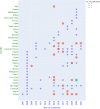
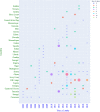
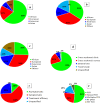
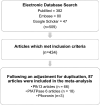
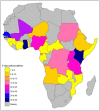
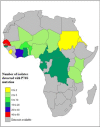
Similar articles
-
Absence of association between polymorphisms in the pfcoronin and pfk13 genes and the presence of Plasmodium falciparum parasites after treatment with artemisinin derivatives in Senegal.Int J Antimicrob Agents. 2020 Dec;56(6):106190. doi: 10.1016/j.ijantimicag.2020.106190. Epub 2020 Oct 9. Int J Antimicrob Agents. 2020. PMID: 33045351
-
Molecular assessment of atpase6 mutations associated with artemisinin resistance among unexposed and exposed Plasmodium falciparum clinical isolates to artemisinin-based combination therapy.Malar J. 2012 Nov 9;11:373. doi: 10.1186/1475-2875-11-373. Malar J. 2012. PMID: 23140394 Free PMC article.
-
A review of the frequencies of Plasmodium falciparum Kelch 13 artemisinin resistance mutations in Africa.Int J Parasitol Drugs Drug Resist. 2021 Aug;16:155-161. doi: 10.1016/j.ijpddr.2021.06.001. Epub 2021 Jun 10. Int J Parasitol Drugs Drug Resist. 2021. PMID: 34146993 Free PMC article. Review.
-
Local emergence in Amazonia of Plasmodium falciparum k13 C580Y mutants associated with in vitro artemisinin resistance.Elife. 2020 May 12;9:e51015. doi: 10.7554/eLife.51015. Elife. 2020. PMID: 32394893 Free PMC article.
-
Emerging Plasmodium falciparum K13 gene mutation to artemisinin-based combination therapies and partner drugs among malaria-infected population in sub-Saharan Africa.Parasites Hosts Dis. 2025 May;63(2):109-122. doi: 10.3347/PHD.24053. Epub 2025 May 26. Parasites Hosts Dis. 2025. PMID: 40452273 Free PMC article. Review.
Cited by
-
Emergence of Plasmodium falciparum strains with artemisinin partial resistance in East Africa and the Horn of Africa: is there a need to panic?Malar J. 2024 Jan 25;23(1):34. doi: 10.1186/s12936-024-04848-8. Malar J. 2024. PMID: 38273360 Free PMC article. Review.
-
Molecular Surveillance of Artemisinin-Resistant Plasmodium falciparum Parasites in Mining Areas of the Roraima Indigenous Territory in Brazil.Int J Environ Res Public Health. 2024 May 25;21(6):679. doi: 10.3390/ijerph21060679. Int J Environ Res Public Health. 2024. PMID: 38928926 Free PMC article.
-
The prevalence of Pfk13 polymorphism in malaria patients treated with artemisinin-based therapy: a systematic review and meta-analysis.Parasitol Res. 2024 May 14;123(5):209. doi: 10.1007/s00436-024-08203-3. Parasitol Res. 2024. PMID: 38740597
-
Bibliometric analysis of antimalarial drug resistance.Front Cell Infect Microbiol. 2024 Feb 12;14:1270060. doi: 10.3389/fcimb.2024.1270060. eCollection 2024. Front Cell Infect Microbiol. 2024. PMID: 38410722 Free PMC article. Review.
-
Prevalence of Plasmodium falciparum parasites harbouring chloroquine-resistant but not artemisinin-resistant alleles in Busia County, Western Kenya.Malar J. 2025 Jul 30;24(1):247. doi: 10.1186/s12936-025-05486-4. Malar J. 2025. PMID: 40739505 Free PMC article.
References
-
- WHO . Report on antimalarial drug efficacy, resistance and response: 10 years of surveillance (2010–2019) Geneva: World Health Organization; 2020.
-
- Akinola O, Egboro DE, Iyenmoana E, Abdulkadir BF, Yakub YO, Adeosun AA, et al. Prevalence of antimalarial drug resistant markers in kwara, north-central, Nigeria: a decade after replacement of chloroquine and antifolates as first-line regimen. Am J Trop Med and Hyg. 2019;101:78. - PubMed
-
- Baraka V, Mavoko HM, Nabasumba C, Francis F, Lutumba P, Alifrangis M, et al. Impact of treatment and re-treatment with artemether-lumefantrine and artesunate-amodiaquine on selection of Plasmodium falciparum multidrug resistance gene-1 polymorphisms in the Democratic Republic of Congo and Uganda. PLoS One. 2018;13:e0191922. - PMC - PubMed
Publication types
MeSH terms
Substances
Grants and funding
LinkOut - more resources
Full Text Sources
Other Literature Sources

